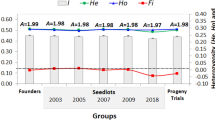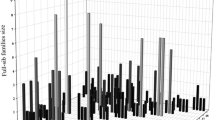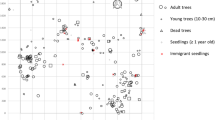Abstract
Seed orchards of forest trees are established to produce genetically-improved seed for reforestation. Genetic efficiency requires seed orchards to be (1) reproductively isolated form surrounding trees, (2) that there be similar fertilities among all orchard trees, and (3) minimum inbreeding. Each aspect of seed orchard reproduction can be simultaneously estimated using the observed frequency of each multilocus gametic type contributed through fertilizing pollen and the expected multilocus gametic segregation frequencies of orchard tree and of the contaminating population. These genetic estimates are directly relevant to the genetics of the tree breeding program. The flexibility of sampling seed — the basic data for these techniques — allows great scope for hypothesis testing, including tests of the accuracy of predictions of biophysical models of pollen movement. A simple example and a white spruce seed orchard case study are presented to illustrate the estimation technique and to investigate its sensitivity.
Similar content being viewed by others
References
Adams WT, Birkes DS (1989) Mating patterns in seed orchards. Proc 20th South Forest Tree Improv Conf. Charleston, South Carolina, pp 75–86
Adams WT, Birkes DS (1991) Estimating mating patterns in forest tree populations. In: Fineschi S, Malvolti M, Cannata F, Hattemer HH (eds) Biochemical markers in population genetics of forest trees. SPB Academic Publishing, The Hague, pp 157–172
Adams WT, Birkes DS, Erickson VJ (1992) Using genetic markers to measure gene flow and pollen dispersal in forest tree seed orchards. In: Wyatt R (ed) Ecology and evolution of plant reproduction. Elsevier, New York, pp 37–61
Brown AHD (1989) Genetic characterization of plant mating systems. In: Brown AHD, Clegg MT, Kahler AL, Weir BS (eds) Plant population genetics, breeding, and genetic resources. Sinauer Associates Inc, Sunderland, pp 145–162
Brown AHD, Barren SCH, Morgan GF (1985) Mating system estimation in forest trees: models, methods and meanings. In: Gregorius HR (ed) Population genetics in forestry. Springer, Berlin Heidelberg New York, pp 32–49
Devlin B, Roeder K, Ellstrand NC (1988) Fractional paternity assignment: theoretical development and comparison to other methods. Theor Appl Genet 76:369–380
Di-Giovanni F, Beckett PM (1990) On the mathematical modelling of pollen dispersal and deposition. J Appl Meteor 29:1352–1357
Di-Giovanni F, Kevan PG (1991) Factors affecting pollen dynamics and its importance to pollen contamination: a review. Can J For Res 21:1155–1170
Elant-Johnson, RC (1971) Probability models and Statistical methods in genetics. Wiley, New York
El-Kassaby YA, Ritland K (1986) Low levels of pollen contamination in a Douglas-fir seed orchard as detected by allozyme markers. Silvae Genetica 35:224–229
Epperson BK, Allard RW (1987) Linkage disequilibrium between allozymes in natural populations of Lodgepole pine. Genetics 115:341–352
Friedman ST, Adams WT (1981) Genetic efficiency in loblolly pine seed orchards. In: Proc 10th South Forest Tree Improv Conf. Blacksburg, Virginia, pp 213–234
Hamrick JL, Schnabel A (1985) Understanding the genetic structure of plant populations: some old problems and a new approach. In: Gregorius HR (ed) Population genetics in forestry. Springer, Berlin Heidelberg New York, pp 50–70
Meagher TR (1986) Analysis of paternity within a natural population ofChamaelirium luteum. I. Identification of most-likely male parents. Am Nat 128:199–215
Neale DB (1984) Population genetic structure of the Douglas-fir shelterwood regeneration in southwest Oregon. PhD thesis, Oregon State University, Corvallis
Schoen DJ, Stewart SC (1986) Variation in male reproductive investment and male reproductive success in white spruce. Evolution 40:1109–1121
Schoen DJ, Stewart SC (1987) Variation in male fertilities and pair-wise mating probabilities inPicea glauca. Genetics 116:141–152
Searle SR (1971) Linear models. Wiley, New York
Smith DB, Adams WT (1983) Measuring pollen contamination in clonal seed orchards with the aid of genetic markers. In: Proc 17th South Forest Tree Improv Conf. Athens, Georgia, USA, pp 68–77
Squillace AE, Long EM (1981) Proportion of pollen form nonorchard sources. In: E. C. Franklin (ed) Pollen management handbook. USDA Agriculture Handbook 587, Washington, D.C, pp 15–19
Yazdani R, Lindgren D, Stewart SC (1989) Gene dispersion within a population ofPinus sylvestris. Scand J For Res 4:295–306
Author information
Authors and Affiliations
Additional information
Communicated by C. Smith
Rights and permissions
About this article
Cite this article
Stewart, S.C. Simultaneous estimation of pollen contamination and pollen fertilities of individual trees in conifer seed orchards using multilocus genetic data. Theoret. Appl. Genetics 88, 593–596 (1994). https://doi.org/10.1007/BF01240923
Received:
Accepted:
Issue Date:
DOI: https://doi.org/10.1007/BF01240923




